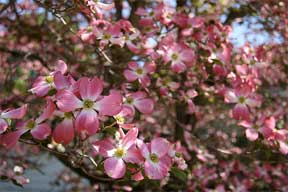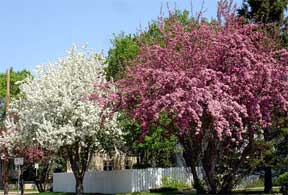Of course you want trees in your landscape. Too frequently, though, the trees you wish to have will grow too large for your property and will also hinder the growth of smaller plants and shrubs. A good solution is to select small, flowering trees such as those discussed below, three of which are native to North America.
These, and many others, are especially adaptable to the small garden. Most of them bear flowers and lustrous fruits, have handsome foliage and picturesque branching habits in summer and winter. They are suitable for a wide range of climatic and soil conditions.
Among flowering trees, the dogwoods are almost certain to be thought of first. Here is a group of trees and large shrubs which is widely spread over the United States. Dogwoods thrive in various soils and require relatively little care or attention, growing nearly as well in shady places under large trees as in sunny localities.

Dogwoods Flowers – Two Types
Dogwood flowers are of two types – those with petal like bracts which surround the very small flowers and those with flowers borne in showy, flat-topped clusters. You can enjoy these flowers in the spring, then the beautiful foliage in summer and autumn, and finally the fruits in fall which to the bird lover have a specific recommendation in that they are much sought after by some fifty kinds of songbirds. And in addition to these qualities, several of the dogwoods have brightly colored branches and twigs which during winter brighten a landscape which might otherwise lack color.
Perhaps you have wondered why these trees and shrubs are called dogwoods. The name “dogwood” comes from the ancient medicinal value of the bark of the tree. It is reported that a special decoction from a European species was used to wash mangy dogs, and the bark and fresh twigs of various species have been used as fever preventives, toothpaste and scarlet dye!
It may seem almost distasteful to associate such a non-aesthetic derivation with the flowering dogwood (Cornus florida), one of the most beautiful American flowering trees. Its spreading branches covered in early spring with resplendent white bracts surrounding the greenish-yellow inconspicuous flowers are spectacular, and woodlands and gardens from Southwestern Maine to Florida and Texas are brightened by their beauty. The leaves, developing immediately after flowering, are of a medium to dark green above and whitish beneath. In the fall, as the leaves assume a brilliant autumn color of bright yellow to orange and red, the scarlet fruits, borne in dense clusters but individually distinct, begin to show.
Red-Osier Dogwood
The red-osier dogwood (Cornus smlonifera) is of a shrub like habit of growth, seldom reaching a height greater than 12 or 15 feet. It is a loose, broad-spreading plant with prostrate branches at the base, and its stoloniferous habit makes it particularly useful in naturalistic plantings. It is extremely hardy in the Northern and Central states and is usually found growing near water but is tolerant to drought and sun or shade. Its numerous clusters of small white flowers are borne in May to June, and in winter the plant makes a very handsome spectacle with its blood-red branches and white to bluish berry-like fruit. This plant alone is visited in winter by some twenty kinds of songbirds and in the wild is a browse plant for several animals. including the deer, moose and rabbit.
The Dark Blue Fruits
For dark blue fruits the pagoda dogwood (Cornus alterifolia) may be used. This is native to the Eastern and Central states and is found along ravines, hedgerows and woodland borders. Its ultimate height is from 20 to 25 feet and it has a spread equal to its height with the lower branches sweeping the ground. The layered appearance of its foliage is particularly pleasing. In spring the light green leaves are whitened by the flowers arranged in dense creamy white clusters, 1 1/2 to 2 1/2 inches across. The flowers are followed in early summer with globular dark-blue fruits, 1/3 inch across, on colorful red stems. And in the autumn as the leaves develop a deep red color you will find its beauty is unforgettable.
American Hawthorns
The American hawthorns are becoming more and more popular as ornamentals. This is a very large group, with over 900 species having been described that are widely distributed over North America. Their numerous white to red flowers are borne in broad flat-topped clusters, the outer flowers opening first, and appear in late spring usually after the leaves. The conspicuous fruits extend among the different species from August to early winter and midwinter in some species; their bold rugged branching habits make them very interesting subjects when their leafless forms are outlined in a winter landscape. You cannot make any mistake in planting them in liberal quantities.
One of the best hawthorns for the South is the Washington thorn (Crataegus phaenopyrum). This plant deserves a place in the garden for any one of a number of reasons: for its foliage of distinctly lobed, dark green and glossy leaves; for its white flowers, usually about 1/2 inch across in many-flowered clusters in May and June; for its scarlet to coral-red fruits produced in September and October and remaining without shrinkage or loss of color until early winter – its fruits are especially shiny from which it gets its species name phaenopyrum, from the Greek “to shine”; or for its general vigorousness, densely compact ovate head of slender, thorny branches.
Sturdy Small Tree
A sturdy small tree, vigorous and strong, is the cockspur thorn (Crataegus crus-galli). The habit of growth makes a low, flat-topped tree with broadly spreading, stratified branching, fairly dense. It’s found from Quebec to North Carolina and Kansas. Its sharply saw toothed leaves develop in late spring and persist to very late fall when they turn a red-bronze color. The white flowers, about 1/2 inch across, appear after the leaves and are borne in many-flowered clusters. The dull red fruits begin to become conspicuous in late summer and remain on the tree into winter. They are somewhat globular in shape and measure about % inch across.
The Fringe Tree
The fringe tree is valued chiefly for the beauty and fragrance of its flowers. Chionanthus virginica is a plant deserving much attention as an ornamental. It is found from Pennsylvania to Florida and Texas but is also hardy North in somewhat sheltered positions. Reaching a height of from 15 to 30 feet, it makes a graceful form, with spreading branches, round-topped, usually taller than broad. The flowers are about 1 inch long and are produced in pendulous panicles measuring 4 to 8 inches long. This is a dioecious plant, that is, staminate (male) and pistillate (female) flowers are borne on separate plants. The staminate flowers are more striking in appearance due to their larger panicles and broader petals but lack the attractive dark blue, oval-shaped fruits in autumn. A special desired characteristic for some gardeners is that this plant performs well in cities and endures smoke and dust.
In ornamental cherries the United States offers many forms; however, for home planting some of the hybrids and non-native species are best. Also many of our cherries are large trees… too large for the small garden. There is one, the choke cherry (Prunus virginiana), worth considering for naturalistic plantings only. This is native in general to North America, on waste land and sandy soil. It is a small tree, seldom of a height greater than 20 feet, with crooked branches and slender twigs forming an oval crown. It will grow in a wide variety of soils, in full sunlight and in shade of large trees. The tiny white flowers appear with the leaves, covering the main stems, and the rdeep redcolored fruits in late summer are a delicacy for birds.
Unforgettable Beauty
Unforgettable is the beauty of the redbud or Judas tree (Cercis camzdensis), a native to eastern North America as undergrowth in woodlands. It often reaches a height of 20 feet and develops 2 a broad, slightly rounded crown of spreading, angular branches, the trunk often dividing low into several strongly ascending parts. The pea-like flowers, pink in color with a magenta cast, are borne in clusters profusely produced in early spring before the leaves. (There is a white-flowered variety, equally lovely.) In summer the leaves, 3 to 6 inches long and often broader than long, are extolled by everyone.
A native to the Eastern and Southern states near the coast in marshes is the sweet bay (Magnolia virginiana). This is a small, irregular tree or sometimes a, large shrub with a height of 15 feet, having a crooked trunk and a loose, open crown. In the South its long glossy leaves are a pleasure both in summer and winter, but for the Northern states the plant becomes deciduous. This magnolia has a long flowering season, a value which many other trees do not have, with its sweet-scented, creamy white, cup-shaped flowers, measuring from 2 to 4 inches across, continually produced from late spring to early fall. And the bright red fruits borne in cones must not be forgotten.

A tree frequently planted in the North but practically unnoticed in the South is the shadbush or Juneberry (Amelanchier canadensis). This is a bushy tree of erect and columnar branches reaching a height of 20 to 25 feet. In early spring before leafing it produces a profusion of white flowers and it is said they appear concurrently with the shad runs of Eastern localities. The summer crop of fruit, almost black with a bloomy appearance, is attractive among the shiny green leaves and attracts many birds. With this ornamental distinction as well as high tolerance to poor soils, dry climates, and resistance to salt sprays, there should be a place for this tree in many gardens.
Crabapples
The crabapples are another easily handled group of flowering trees. They have good growth habits, making them especially useful for the smaller garden. Their beauty has long been appreciated, as they have been in cultivation since 1724. There are three that are especially good, the prairie crab (Malus ioensis), the garland or sweet crab 2 (Malus coronaria), and the southern crab (Malus angustifolia).
The prairie crab is the first of the native crabs to bloom. Its bright pink, very fragrant flowers usually appear as the leaves are developing and are followed by fruits of a dull green color with numerous light-colored spots. In the fall you will admire the colored leaves before they fall from the picturesque, irregular branches. The garland crab, with a native range from New York to Alabama and west to Missouri, is a low, bushy tree, with thorny angular twigs, the trunk often bent or swayed, the crown dense in youth-becoming more open and irregular with age. The fragrant flowers are, a bright rose when opening, turning a faint pink. The fall crop of fruits has been used for jellies and preserves and in the wild it provides wildlife food.
In late spring many woodland spots from Vermont to Florida are beautified by the flowers of the southern crab. This small tree, to 20 or 25 feet high, with numerous spreading or horizontal branches, makes a magnificent sight, as a specimen plant or in groups, when the rose-pink flowers are borne in profusion all along the branches. It is also of value to lengthen the crab season. Truly, the performance of this tree alone might easily turn the gardener toward greater appreciation of our own native plants.
Contributed by B Bridgers
